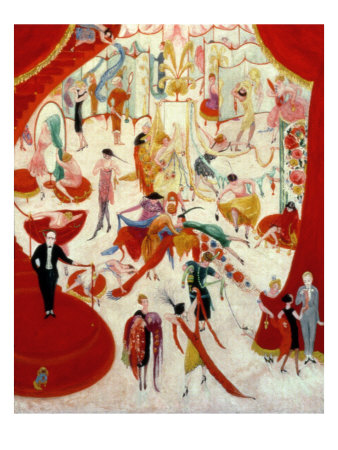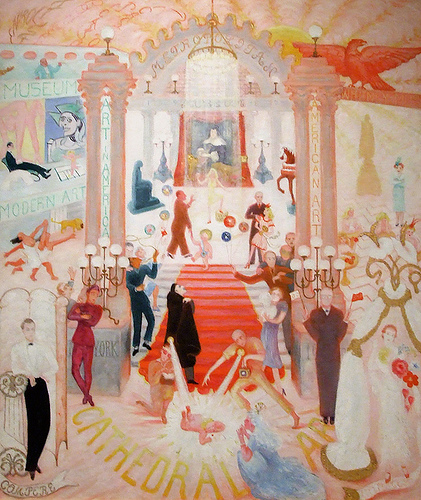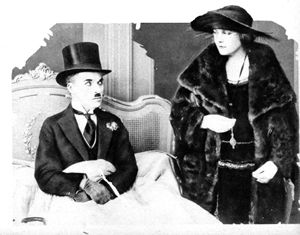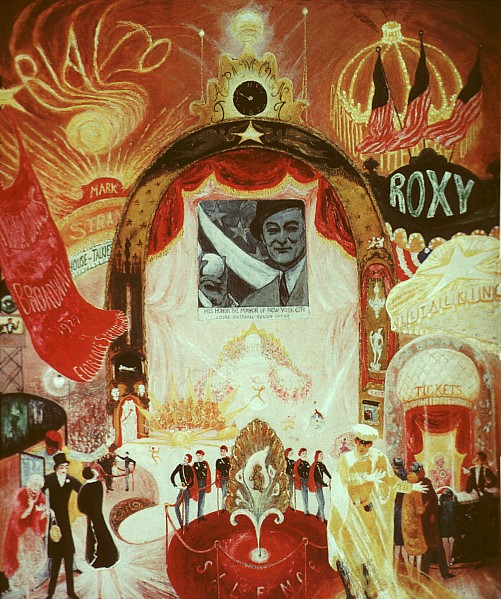Florine Stettheimer: Feminine Observations From The Idle Class
Florine Stettheimer was among the most original American painters of her generation. Her lengthly creative peak began in 1916 until her death in 1944 which occurred while painting. Stettheimer viewed art as ”an entirely private pursuit”. There was no existing precedent for Stettheimer’s work and no-one has painted like her since. The approach was personal and idiosyncratic, non-conforming and inflected with wry social comment. The decorative, figurative, feminine and surreal effortlessly coexist within a slightly eccentric color palette. Stettheimer’s work is fine art that incorporates elements of popular illustration with a naievity that is calculated, purposeful and somewhat unsettling.
Stettheimer is a virtual unknown to the general public . She melded folk art, a passion for modern costume, set design, theatre and the ballet into her intricate paintings. The result was a vibrancy and complexity that teetered near the precipice of whimsey without crossing into the common or derivative. She was also a gifted poet . Stettheimer received critical recognition for her set design and costumes in the 1934 Opera ” Four Saints In Three Acts” by Gertrude Stein and Virgil Thomson which featured an all-black cast among other noteworthy innovations. It is these multitude of talents and skills that are exemplified in ” Spring Sale at Bendel’s”:
A reason for her lack of recognition is her non-conformity to any given genre of painting. She had a classic instuction then moved to impressionism and opened a studio in Munich. Around 1912 she revolted against all academic formalities and returned to the United States in 1914. From New York, she defined her unique vision which ran contrary to the prevalent high-mindedness of modern art. The wit , irony, and sense of outrage found in her work ; her feminine projection and bohemian predispositions were deemed non-marketable by museums and galleries. Her success in evading any attempt to stylistically categorize her in a definitive fashion also contributed to limiting her appeal within establishment art circles . Her paintings were always ”unveiled” at private salon parties. At the same time, Stettheimer never exhibited after 1916 and made no effort to self promote.After her death, most of Stettheimer’s art was donated to museums who reluctantly accepted the works, then mothballed the paintings into storage. Thus, there is no art market for her paintings. The last exhibition of Stettheimer paintings dates to 1995 at the Whitney Museum.
Stettheimer unabashadly conveyed her femininity in her paintings.It was considered unique for a woman to joyously proclaim her gender on canvas particularly through the use of”colorist” techniques. Her use of chromatics differed radically form existing colonialist application of ”Americana” that had been the norm in the US to that time. Her vision of Americana was urban and industrial. This was a world seen through feminine eyes, by a woman who regarded her wealth as a birthright and her social life as a series of boating parties, picnics, lunches, intellectual gatherings and parades.
Like Franz Kafka, Stettheimer’s will and testament contained instructions to destroy all her art work after death. Also, like Kafka, she successfully fused the abstract with the sociological within a compositional style that was totally without precedent.
Stettheimer was somewhat influenced by friend and painter Marcel Duchamp and his concept of ”multiplication virtuelle” where separate incidents simultaneously inhabit a single picture. A good example is ”Cathedrals of Broadway” :
She was born in Rochester to a wealthy German born international banking family. Stettheimer wisely managed her money to guarantee the luxury of never formally working a day in her life. Unfortunately, there is a paucity of information available on Stettheimer as subject study within early modern art. This is in part due to the rise of American abstract impressionism in the 1950′s which eclipsed attention for the period between the two world wars. However, Her love of ballet, her vibrant femininity and her comprehension of the forces at play within modern life lend itself to this short video:




